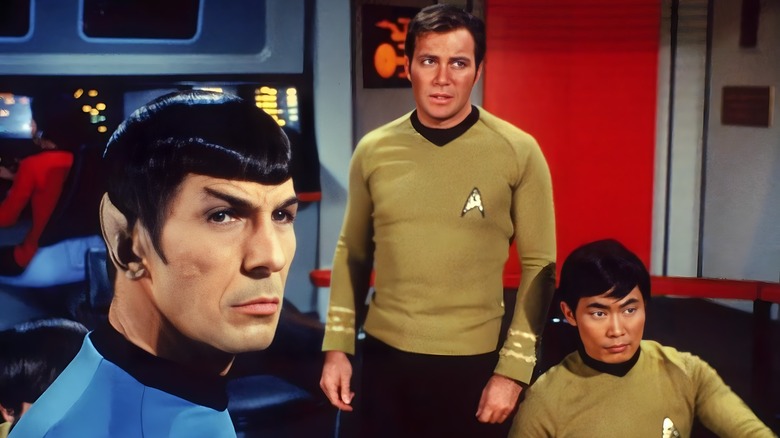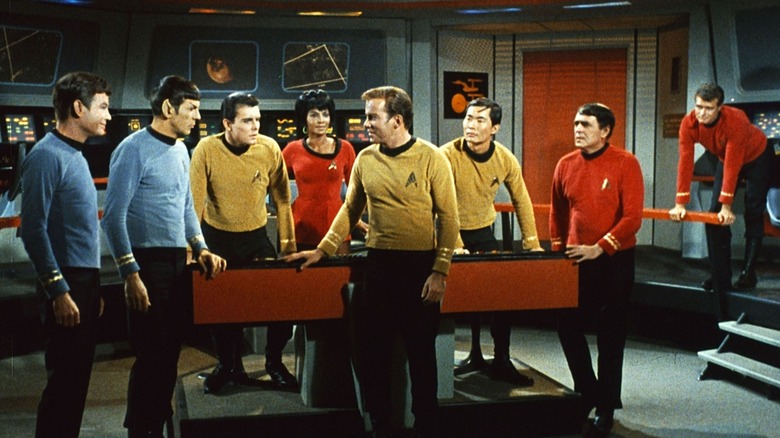How A Classmate And An Ex-Con Led Gene Roddenberry Closer To Star Trek
It may startle people to learn that Gene Roddenberry, the creator of "Star Trek," "Genesis II," "Earth: Final Conflict," and "Andromeda" was not always a sci-fi fan. As a boy, he loved reading pulp adventure novels, but he wasn't any more drawn to sci-fi stories like "John Carter of Mars" than he was to period adventure tales like "Tarzan the Ape Man." He did also read more authors than Edgar Rice Burroughs. When it came time to choose a major in college, Roddenberry didn't take classes in creative writing, but aeronautical engineering.
Roddenberry was also a pilot and a member of the United States Air Force in the 1940s until a bad runway approach took him out of combat. He survived several other plane crashes besides. He also worked for the Los Angeles Police Department for most of the 1950s. While working as a cop, Roddenberry started penning his first scripts under the penname Robert Wesley and quit to write full-time in 1956. His entire background can be found in David Alexander's 1994 book "Star Trek Creator: The Authorized Biography of Gene Roddenberry."
Roddenberry's path to "Star Trek" is more closely analyzed in "The Fifty-Year Mission: The Complete, Uncensored, Unauthorized Oral History of Star Trek: The First 25 Years," edited by Mark A. Altman and Edward Gross. In that book, Roddenberry looked back over his childhood, looking for sci-fi influences, and sharply recalled two people who directed his creative energies toward sci-fi. One of them was a nerd who read a lot of sci-fi novels. The other was an ex-con who lived in a garage in his neighborhood. He, too, read a lot of sci-fi novels.
The nerd and the ex-con
"The Nerd and the Ex-con" sounds like an adventure story unto itself. Gene Roddenberry recalled a nerdy classmate with health issues who was really, really into tales of space travel. In talking to him, Roddenberry learned about how exciting the genre was. In the 1920s and 1930s, sci-fi was popular in magazine form, and a lot of old magazines compiled classic stories and printed new tales and essays from local authors. It was in the letter columns of sci-fi magazines that modern fandom — as we might know it — began to form in earnest. Roddenberry said:
"There was a boy in my class who life had treated badly. He limped, he wheezed. He was a charming, intelligent person. Because of being unable to do many of the things that others were able to do, he had sort of gone into his own world of fantasy and science fiction. He had been collecting the wonderful old Amazing and Astounding Magazines, and he introduced me to science fiction."
The full name of Astounding Magazine was Astounding Stories of Super-Science. It later changed its name to Analog Science-Fiction and Fact. The magazine is still in print to this day. Meanwhile, Amazing Magazine was actually Amazing Stories, founded by author Hugo Gernsback. It was after Gernsback that the prestigious Hugo Awards were named. Amazing Stories is still published occasionally.
Unfortunately, Roddenberry didn't say which stories or authors, in particular, he and his classmate bonded over. If he had, surely enterprising collectors and Trekkies would have tracked down the issues Roddenberry read and consumed them voraciously. Regardless, old sci-fi magazines are worth a look.
We had Burroughs in prison
Thanks to the caprices of a prison library curator, Gene Roddenberry would be brought to the world of Edgar Rice Burroughs. He recalls a man living in his L.A. neighborhood who discovered the famed adventure author while serving time. Roddenberry said:
"I then discovered in our neighborhood, living above a garage, an ex-con who had come into science fiction when he was in prison. He introduced me to John Carter and those wonderful Burroughs things. By the time I was 12 or 13, I had been very much into the whole science fiction field."
It seems that those novels planted a germ in Roddenberry's head, eventually manifesting in sci-fi sagas like "Star Trek." The names of the mysterious ex-con and the nerdy classmate were not shared with the "Fifty-Year Mission" editors. Burroughs, meanwhile, might be called one of the champions of pulp literature, and his many, many adventure stories inflamed the imaginations of millions of youngsters. Incidentally, the city of Tarzana, California was named after "Tarzan" when Burroughs moved there with his family in 1919.
Of course, Burroughs' stories are often read as aggressively colonialist, with brave white American heroes charging into "foreign lands" to impose their will on others. "Star Trek," in contrast, often attempts (with mixed success) to tell anticolonialist stories (the Prime Directive assures that Starfleet officers don't mess around with other cultures). Sci-fi novels and geek magazines cracked open the door. Roddenberry's personal politics completed the picture.


